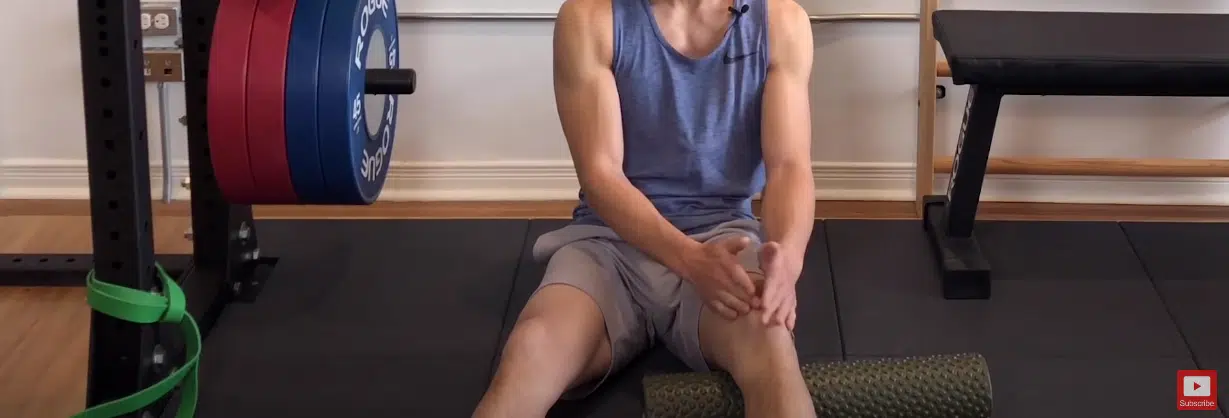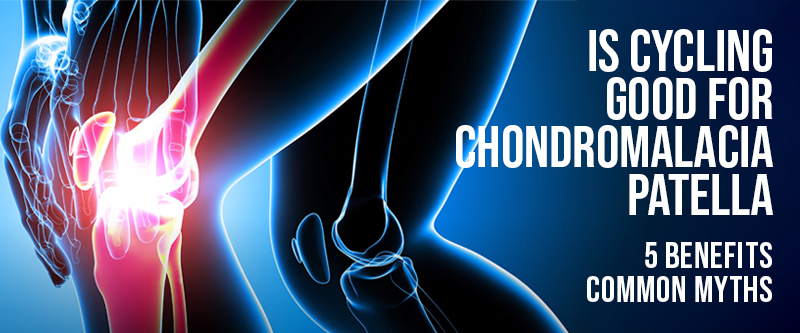The cartilage under the kneecap is affected by Chondromalacia Patella, leading to pain and discomfort in the knee joint. Cycling has numerous benefits that complement physical therapy and rest for this condition.
A stationary bike is one of the best exercises for treating patellar chondromalacia. Due to the low-impact nature of this exercise regimen, it is often possible to build up strength, which allows the patellar chondromalacia to be absorbed better and have fewer symptoms.
It will discuss the benefits of cycling for Chondromalacia Patella and precautions cyclists can take to prevent further damage. We’ll also debunk common misconceptions and explore other factors to consider.
Is Cycling Good for Chondromalacia Patella: 5 Benefits

A chondromalacia patella causes pain, swelling, and difficulty moving the knee because the cartilage under the kneecap becomes soft. Cycling can be beneficial for people with Chondromalacia Patella despite its challenges.
Low Impact Exercise
Cycling is a gentle, low-impact exercise on the knee joint compared to higher-impact activities such as running or jumping. This makes it an ideal choice for those with chondromalacia patella who need to avoid excessive knee strain.
Cycling has been found to significantly reduce pain and improve function in people with osteoarthritis, a condition similar to the chondromalacia patella.
Strengthening of Muscles Surrounding the Knee
The muscles in your legs and those surrounding your knee joint are strengthened by cycling. These muscles, including your quadriceps and hamstrings, support your knee joint and prevent further instability and pain.
Cycling can improve the alignment of your lower body, ensuring that your knee joint is not under unnecessary stress during exercise.
Improvement in Joint Mobility
When left untreated, chondromalacia patella can cause stiffness and limited mobility in the knee joint. Cycling can help to improve joint mobility and flexibility by increasing knee range of motion. Repeated cycling can help loosen up the joint and reduce stiffness, allowing for greater ease of movement.
Enhanced Cardiovascular Health
A bike ride can increase your heart rate, lower blood pressure, and improve cardiovascular health. This is particularly important for individuals with chondromalacia patella, as regular physical activity can help to improve blood flow to the knee joint, promoting healing and preventing further damage.
Prevention Against Further Deterioration of the Knee Joint
Cycling is highly beneficial for those with chondromalacia patella. It helps prevent knee joint deterioration by strengthening muscles, improving joint mobility, and reducing pressure on cartilage. Regular cycling also helps maintain a healthy body weight, lowering the risk of future knee issues.
Chondromalacia Patella and Cycling: Various Precautions
It is vital to take precautions to ensure that cycling does not exacerbate symptoms and further damage the knee joints. We will explore the various precautions cyclists with chondromalacia patella can take to pursue this activity safely and effectively.
Consultation with a Medical Professional
You should consult your physician before starting any exercise program, especially if you suffer from chondromalacia patella. A medical professional can provide invaluable advice on safely exercising with the condition, recommend appropriate treatments, and monitor any changes or worsening symptoms.
Proper Warm-up and Stretching Techniques

Warming up and stretching before cycling will increase blood flow, improve flexibility, and reduce injury risk. Here are some tips for proper warm-ups and stretching techniques:
- Start with a gentle warm-up before cycling, such as walking or light cycling, for 5 to 10 minutes.
- Stretch your quadriceps, hamstrings, and calves before and after cycling.
- Hold each stretch for at least 30 seconds, and aim to stretch each muscle group at least twice.
- Avoid overstretching or bouncing during stretches, which can increase the risk of injury.
Adjustments to Cycling Posture and Technique
Cycling posture and technique can reduce knee joint stress and alleviate pain and discomfort. Here are some tips for correct cycling posture and technique:
- Adjust the bike seat height so the pedals are at their lowest point.
- Keep the knee facing directly forward when pedaling rather than angling your knee inward or outward.
- Use a higher gear and a lower pedal cadence to reduce knee stress.
- Avoid sudden or jerky movements on the bike, which can exacerbate knee pain.
Use of Appropriate Protective Gear
Using appropriate protective gear can help prevent injury or aggravation to the knee joint. Here are some critical protective gear items to consider:
- Proper cycling shoes with a rigid sole distribute pressure evenly across the foot, reducing knee pain.
- Consider wearing knee pads or compression sleeves to support the knee joint.
- Wear padded cycling shorts to reduce saddle pressure and skin irritation.
Managing Pain and Inflammation
Managing pain and inflammation is essential for cyclists with chondromalacia patella. Here are some tips for managing pain and inflammation:
- Use ice or heat therapy to reduce pain and inflammation after cycling.
- As your medical professional recommends, take over-the-counter pain medications such as acetaminophen or ibuprofen.
- Consider cycling on flat terrain or using a stationary bike to reduce knee stress.
Chondromalacia Patella Cycling: Best Treatment
If you have chondromalacia patella caused explicitly by cycling, you need to consider treatment options that address the unique demands and stresses on the knee joint.
Patella Stabilizing Braces
Patella stabilizing braces are valuable tools for cyclists with chondromalacia patella as they provide support and alignment for the kneecap during cycling activities. These braces help stabilize the patella, reduce lateral movement, and improve patellar tracking, crucial for minimizing knee pain and discomfort while cycling. By wearing patella stabilizing braces during rides, cyclists can enhance knee stability, reduce the risk of malalignment, and maintain proper patellar function throughout their cycling sessions.
Physical Therapy for Quadriceps Strengthening
Cycling relies heavily on the quadriceps muscles for power generation and pedal stroke efficiency. Physical therapy focusing on quadriceps strengthening is essential if cyclists have osteomalacia patella to improve muscle balance, stability, and control around the knee joint.
Tailored exercises targeting quadriceps strength can help cyclists optimize muscle function, reduce imbalances, and alleviate stress on the patellar cartilage during cycling. Strengthening the quadriceps can also enhance pedal stroke mechanics and overall cycling performance, making it a valuable component of chondromalacia patella treatment for cyclists.
Orthotics to Decrease Pronation of the Foot
Foot pronation issues can affect lower limb alignment and exacerbate knee pain in cyclists with chondromalacia patella. Using orthotic inserts designed to correct foot pronation can help cyclists achieve better foot alignment, distribute pressure more evenly, and reduce strain on the knee joint during cycling.
Orthotics that decrease foot pronation are crucial in optimizing pedal stroke mechanics, enhancing cycling efficiency, and reducing the risk of knee injuries associated with chondromalacia patella in cyclists.
Nonsteroidal Anti-Inflammatory Medication
Nonsteroidal anti-inflammatory drugs (NSAIDs) can be beneficial for cyclists with chondromalacia patella to manage pain, inflammation, and swelling associated with cycling-related knee issues. NSAIDs like ibuprofen or naproxen can help reduce pain levels, improve ride comfort, and address acute flare-ups of knee discomfort in cyclists.
By incorporating NSAIDs as needed under the guidance of a healthcare provider, cyclists can enhance their cycling experience, alleviate symptoms of chondromalacia patella, maintain an active lifestyle, and effectively manage knee pain.
5 Exercises For Chondromalacia Patellae
Chondromalacia patellae (runner’s knee) is caused by cartilage damage under the kneecap, causing pain, especially when kneeling during cycling. Exercise can be beneficial in managing this condition and strengthening surrounding muscles. Here are five practical exercises for chondromalacia patellae:
- Quadriceps Stretch: This exercise involves lying face down and bending your knee to bring your heel towards your bottom, using your hand or a towel to create overpressure.
- Straight Leg Raise: Lie on your back with one leg bent and the other extended, then lift the extended leg to engage the
quadriceps muscles. - Side Lying Leg Raise: Raise your leg to the side while lying down, which can help strengthen hip muscles.
- Clamshell: Performing clamshell exercises is beneficial for strengthening hip muscles and supporting the knee.
- Hip Extension Leg Raises: Engage in hip extension leg raises to strengthen the muscles around the hips and knees, which aids in managing Chondromalacia Patellae.
Cycling Is Good for Chondromalacia Patella: Common Myths

There are many misconceptions surrounding the use of cycling for individuals who suffer from Chondromalacia Patella. We will discuss some common myths and provide evidence-based facts to debunk them.
Myth: Cycling Worsens Chondromalacia Patella Symptoms
One of the most widespread misconceptions about cycling and Chondromalacia Patella is that cycling exacerbates the symptoms of the condition. This myth has led many athletes and patients to avoid cycling altogether, fearing it will cause more damage to their knees.
There is no evidence to support this myth. Cycling is considered one of the best low-impact exercises for individuals with knee pain or injury. Here are some evidence-based facts to debunk this myth:
- Cycling is a low-impact exercise that’s low on knee pain.
- Cycling strengthens the muscles in the legs, including the quadriceps, hamstrings, and glutes, which can stabilize the knee joint and reduce injury.
- Cycling can help improve the mobility of the knee joint, reducing pain and inflammation associated with Chondromalacia Patella.
- Exercises like cycling help maintain a healthy weight, reducing the risk of other health conditions aggravating Chondromalacia Patella.
Myth: Cyclists with Chondromalacia Patella Should Avoid Cycling Altogether
Another common myth surrounding Chondromalacia Patella and cycling is that individuals diagnosed with the condition should avoid cycling altogether. This myth can prevent individuals from benefiting from the numerous health benefits associated with cycling and can cause them to miss out on a fun form of physical exercise.
This myth is also unsupported by evidence. Many orthopedic doctors and physical therapists recommend cycling as a safe and effective form of exercise for individuals with Chondromalacia Patella. The following facts debunk this myth:
- Cycling can help improve strength, flexibility, and stability in the knees, reducing the risk of injury and improving overall knee health.
- Cycling can help maintain cardiovascular fitness, reducing the risk of developing other health conditions exacerbating Chondromalacia Patella symptoms.
- Cycling can be adjusted to suit individual needs and preferences. For example, individuals with Chondromalacia Patella can adjust their bike’s seat height and position to reduce stress on the knee joint.
- Low-impact exercises like cycling are easy on the joints and easier to manage than high-impact exercises like running.
Cycling for Chondromalacia Patella: Other Factors
While cycling is generally considered a low-impact exercise that places less stress on your knee joints than running, other factors must be considered in managing your chondromalacia patella symptoms.
Proper Nutrition
The old saying “you are what you eat” couldn’t be more true regarding chondromalacia patella. The knee joint is vulnerable to inflammation, which can be exacerbated by consuming processed and inflammatory foods. By making a few simple changes to your diet, you can help support the health of your joints and reduce your symptoms. Here are a few tips:
- A healthy diet should include healthy fats, fruits, vegetables, and whole grains.
- Omega-3 fatty acids, vitamin D, and antioxidants may help reduce inflammation.
- Processed and refined sugars, unhealthy fats, and refined grains should be avoided.
- A registered dietitian can help you identify nutritional deficiencies causing your symptoms.
Use of Complementary Therapies
While traditional medical treatments such as physical therapy and pain medications are essential for managing chondromalacia patella, complementary therapies can also be beneficial. By incorporating these approaches into their care plans, many people find relief from their symptoms. Here are a few options to consider:
- Acupuncture: This ancient Chinese therapy uses thin needles to reduce pain and inflammation in the body.
- Chiropractic care: Chiropractors can use adjustments and manipulations to realign the joints and reduce pain.
- Massage therapy: It can relieve muscle tension and improve blood flow.
- Yoga or Pilates: These practices can help increase flexibility, strengthen muscles around the knee joint, and reduce stress.
Maintaining a Healthy Weight
Excess weight can increase joint stress, resulting in chondromalacia patella symptoms. Losing even a small amount of weight can help reduce inflammation and improve joint function. Here are a few tips to assist you achieve a healthy weight:
- Diets rich in whole foods and low in processed foods and refined sugars are recommended.
- Regularly engage in physical activity, such as cycling or walking. Aim for at least 150 minutes of moderate-intensity exercise each week.
- Consult a dietitian to develop a healthy, sustainable meal plan.
- You should work with your doctor to identify any obstacles to weight loss, like an underlying medical condition or medication.
Incorporation of Cross-training Exercises

Cycling is a great way to stay fit and improve cardiovascular health. Repeated motion in one direction can strain the knee joint and exacerbate symptoms of chondromalacia patella. Incorporating cross-training exercises into your routine can prevent muscle imbalances and reduce injury risk. Here are a few activities to consider:
- Strength training: This can help build muscle around the knee joint, providing additional support and reducing stress on the joint.
- Swimming: This low-impact exercise is excellent for improving cardiovascular health and strengthening the muscles without putting additional stress on the knee joint.
- Pilates: This practice focuses on building core strength and stability, which can improve body mechanics and reduce the risk of injury.
- Yoga: This practice can help improve flexibility, balance, and strength while reducing stress levels.
Conclusion
Cycling can be an excellent exercise for those who suffer from Chondromalacia Patella. The low-impact nature of cycling and strengthening the muscles surrounding the knee can help prevent further joint deterioration and improve overall joint mobility.
It is essential to take proper precautions and manage your condition with the help of a medical professional. Good warm-up and stretching techniques, adjustment in cycling posture and technique, use of protective gear, and managing pain and inflammation are all necessary precautions cyclists with Chondromalacia Patella should take.
By incorporating these precautions and factors into your cycling routine, you can continue to enjoy the sport while caring for your knee joint health.
FAQs
What Exercises Should You Avoid with The Chondromalacia Patella?
As part of activity modification, avoiding engaging in activities that cause discomfort, such as running, jumping, or squatting, is advisable. By taking these precautions and making mindful adjustments to your physical routine, you can better manage and alleviate any potential discomfort or strain on your body.
Is Cycling Suitable For Chondromalacia Patella?
Stationary bikes are suitable for treating patellar chondromalacia. The reason is that it’s often a low-impact exercise regimen, so you have better absorption and fewer patellar chondromalacia symptoms.


